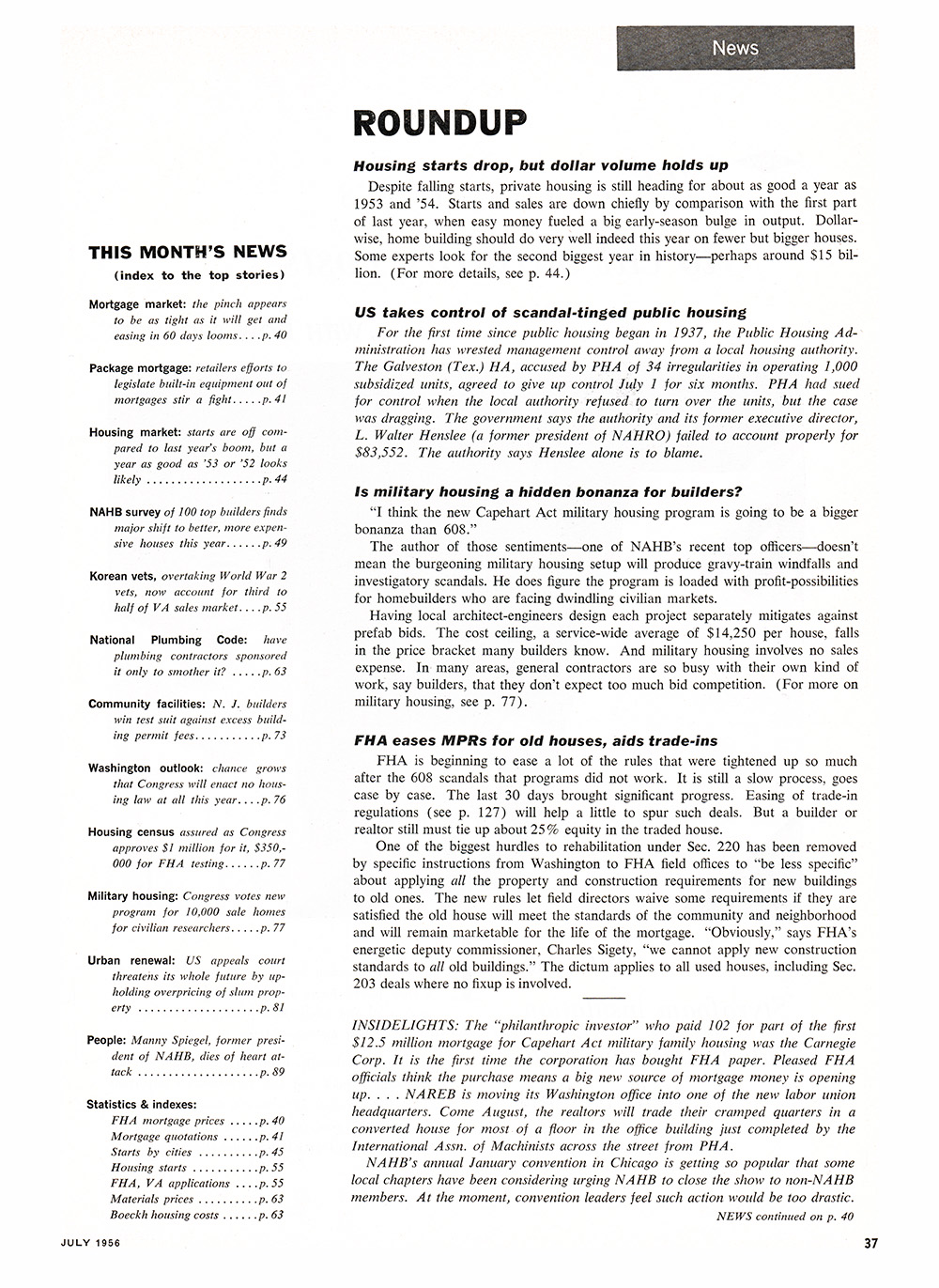


THIS MONTH'S NEWS
(index to the top stories)
Mortgage market: the pinch appears to be as tight as it will get and easing in 60 days looms. . . .p. 40
Package mortgage: retailers efforts to legislate built-in equipment out of mortgages stir a fight.....p.41
Housing market: starts are off compared to last year's boom, but a year as good as '53 or '52 looks likely...................p. 44
NAHB survey of 100 top builders finds major shift to better, more expensive houses this year......p.49
Korean vets, overtaking World War 2 vets, now account for third to half of VA sales market. .. .p. 55
National Plumbing Code: have
plumbing contractors sponsored it only to smother it?.....p. 63
Community facilities: N. J. builders win test suit against excess building permit fees...........p. 73
Washington outlook: chance grows that Congress will enact no hous
ing law at all this year. .. .p. 76
Housing census assured as Congress approves $1 million for it, $350,-000 for FHA testing......p. 77
Military housing: Congress votes new program for 10,000 sale homes for civilian researchers.....p. 77
Urban renewal: US appeals court threatens its whole future by upholding overpricing of slum prop
erty ....................p. 81
People: Manny Spiegel, former president of NAHB, dies of heart attack ....................p. 89
Statistics & indexes:
FHA mortgage prices.....p.40
Mortgage quotations......p. 41
Starts by cities ..........p.45
Housing starts...........p. 55
FHA, VA applications ... .p. 55
Materials prices..........p. 63
Boeckh housing costs......p. 63
ROUNDUP
Housing starts drop, but dollar volume holds up
Despite falling starts, private housing is still heading for about as good a year as 1953 and '54. Starts and sales are down chiefly by comparison with the first part of last year, when easy money fueled a big early-season bulge in output, Dollar-wise, home building should do very well indeed this year on fewer but bigger houses. Some experts look for the second biggest year in history perhaps around $15 billion. (For more details, see p. 44.)
US takes control of scandal-tinged public housing
For the first time since public housing began in 1937, the Public Housing Administration has wrested management control away from a local housing authority. The Galveston (Tex.) HA, accused by PH A of 34 irregularities in operating 1,000 subsidized units, agreed to give up control July 1 for six months. PHA had sued for control when the local authority refused to turn over the units, but the case was dragging. The government says the authority and its former executive director, L. Walter Henslee (a former president of NAHRO) failed to account properly for $83,552. The authority says Henslee alone is to blame.
Is military housing a hidden bonanza for builders?
"I think the new Capehart Act military housing program is going to be a bigger bonanza than 608."¯
The author of those sentiment-”one of NAHB's recent top officer-”doesn't mean the burgeoning military housing setup will produce gravy-train windfalls and investigatory scandals. He does figure the program is loaded with profit-possibilities for homebuilders who are facing dwindling civilian markets.
Having local architect-engineers design each project separately mitigates against prefab bids. The cost ceiling, a service-wide average of $14,250 per house, falls in the price bracket many builders know. And military housing involves no sales expense. In many areas, general contractors are so busy with their own kind of work, say builders, that they don't expect too much bid competition. (For more on military housing, see p. 77).
FHA eases MPRs for old houses, aids trade-ins
FHA is beginning to ease a lot of the rules that were tightened up so much after the 608 scandals that programs did not work. It is still a slow process, goes case by case. The last 30 days brought significant progress. Easing of trade-in regulations (see p. 127) will help a little to spur such deals. But a builder or realtor still must tie up about 25% equity in the traded house.
One of the biggest hurdles to rehabilitation under Sec. 220 has been removed by specific instructions from Washington to FHA field offices to "be less specific"¯ about applying all the property and construction requirements for new buildings to old ones. The new rules let field directors waive some requirements if they are satisfied the old house will meet the standards of the community and neighborhood and will remain marketable for the life of the mortgage. "Obviously,"¯ says FHA's energetic deputy commissioner, Charles Sigety, "we cannot apply new construction standards to all old buildings."¯ The dictum applies to all used houses, including Sec. 203 deals where no fixup is involved.
INSIDELIGHTS: The "philanthropic investor"¯ who paid 102 for part of the first $12.5 million mortgage for Capehart Act military family housing was the Carnegie Corp. It is the first time the corporation has bought FHA paper. Pleased FHA officials think the purchase means a big new source of mortgage money is opening up. . . . NAREB is moving its Washington office into one of the new labor union headquarters. Come August, the realtors will trade their cramped quarters in a converted house for most of a floor in the office building just completed by the International Assn, of Machinists across the street from PHA.
NAHB's annual January convention in Chicago is getting so popular that some local chapters have been considering urging NAHB to close the show to non-NAHB members. At the moment, convention leaders feel such action would be too drastic.
NEWS continued on p. 40